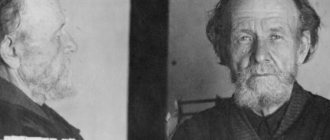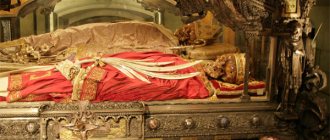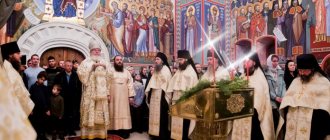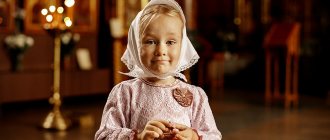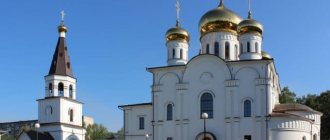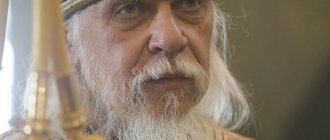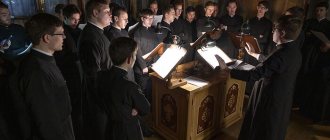| Bishop Pachomius (Bruskov) |
Pachomius (Bruskov)
(born 1976), Bishop of Pokrovsky and Nikolaev, Hiero-Archimandrite of the Irgiz Resurrection Monastery, member of the Inter-Council Presence of the Russian Orthodox Church in the World Dmitry Alexandrovich Bruskov, born July 5, 1976 in Moscow. In the same year he was baptized in the Moscow Church of the Assumption of the Blessed Virgin Mary in Veshnyaki.
In 1983 he entered secondary school No. 671 in Moscow, in 1989 he entered the Moscow Technical Lyceum No. 1 and graduated in 1993.
In 1993, he entered the Moscow State Technological University "Stankin" (Machine Tool Institute) at the Faculty of Information Technologies and in 1997 completed his studies in the specialty "Computer-Aided Design Systems". Awarded a bachelor's degree in engineering and technology in the field of "Automation and Control".
In 1997, he entered the Moscow courtyard of the Trinity-Sergius Lavra as a novice. In 1998 he was accepted into the brethren of the Trinity-Sergius Lavra.
In 1998-2002 he studied at the correspondence sector of the Moscow Theological Seminary.
On April 1, 1999, he was tonsured a monk with a name in honor of St. Pachomius the Great. Hegumen Longin (Korchagin) performed tonsure at the Moscow courtyard of the Trinity-Sergius Lavra.
On July 23, 2000, he was ordained to the rank of hierodeacon in the Church of All Saints on Sokol in Moscow by Archbishop Tikhon (Emelyanov) of Bronnitsky.
In 2003 he was transferred to the Saratov diocese.
On August 28, 2003, he was ordained to the rank of hieromonk in the Cathedral of the Descent of the Holy Spirit in the city of Saratov by Bishop Longin (Korchagin) of Saratov and Volsk.
Since August 29, 2003, he served in the bishop’s church in honor of the icon of the Mother of God “Quench My Sorrows.”
On December 3, 2003, he was appointed economist of the Holy Trinity Cathedral in the city of Saratov.
From January 23, 2004 to December 13, 2011, he served as rector of the same cathedral [1].
On January 11, 2006, he was appointed chairman of the architectural and restoration department of the Saratov diocese.
| Archimandrite Pachomius (Bruskov) |
On April 8, 2007, he was elevated to the rank of abbot.
Since 2005 - confessor of the Saratov Regional Society of Sobriety and Health. Since 2007 - teacher at Saratov Theological Seminary. Since 2007 - member of the Presidium of the regional branch of the All-Russian Society for the Protection of Historical and Cultural Monuments. In 2008-2010 - member of the Public Chamber of the Saratov Region.
On October 6, 2011, by decision of the Holy Synod, he was elected Bishop of Pokrovsky and Nikolaevsky.
On October 14, 2011, he was elevated to the rank of archimandrite.
On December 3, 2011, he was named, and on December 19, he was consecrated Bishop of Pokrovsky and Nikolaevsky. The ordination in the Spaso-Preobrazhensky Cathedral of the Nikolo-Ugreshsky Monastery was led by Patriarch Kirill (Gundyaev) of Moscow and All Rus'. Concelebrating with him were: Metropolitans of Astana and Kazakhstan Alexander (Mogilev), Saransk and Mordovian Barsanuphius (Sudakov), Saratov and Volsk Longin (Korchagin); Archbishops of Yoshkar-Ola and Mari Ioann (Timofeev), Sergiev Posad Feognost (Guzikov), Egorievsky Mark (Golovkov); Bishops of Penza and Kuznetsk Veniamin (Zaritsky), Solnechnogorsk Sergius (Chashin), Nezhinsky and Priluki Iriney (Semko), Balashovsky and Rtishchevsky Tarasy (Vladimirov).
On October 4, 2012, he was confirmed as the holy archimandrite of the Irgiz Resurrection Monastery [2].
Since October 15, 2021, he has been included in the commission for church administration, pastoral care and organization of church life of the Inter-Council Presence of the Russian Orthodox Church [3].
Bishop of Pokrovsky and Nikolaevsky Pachomius. Food for our soul
— Vladyka, please tell me which books belong to spiritual literature? How can we define this concept?
— The concept of “spiritual literature” is quite broad. This is a whole series of books on various topics. Often, spiritual literature includes the works of holy ascetics, who set forth in them the experience of their spiritual life. The main criterion for the spirituality of literature is its compliance with the gospel spirit. These books help you understand the Gospel, get to know the Divine world, improve spiritually, learn prayer, and most importantly, learn to compare your actions with the commandments of Christ.
In the modern world, the concepts of “spirituality” and “spiritual development” have acquired a slightly different meaning than that which is put into it in Christianity. An Orthodox person puts into the concept of “spirituality” the development of the human soul, its desire for God. Therefore, we can probably talk about Muslim and Buddhist spirituality. This is what the authors of the course Basics of Religious Cultures and Secular Ethics proceed from today, assuming the presence of confessional spirituality. And talking about some kind of abstract spirituality, when a person simply imagines images, concepts of some vague spiritual life, is not serious. Sometimes this can even lead to tragedy. Because, not wanting to understand the spiritual, supernatural world, a person can fall under the power of fallen spirits and be seriously damaged.
— Where should a person begin to get acquainted with the world of spiritual literature: from serious works or from the basics?
— The first spiritual book that every person needs to read is the Gospel. Then it’s worth getting acquainted with the interpretation of Holy Scripture. Because the Gospel is a rather specific book, it contains many deep images, historical allusions, and examples. In order to understand them, you need to have a certain skill, knowledge, and conceptual apparatus. Many patristic works allow us to correctly interpret the Holy Scriptures and help us understand what Christ is telling us and teaching us. You can recommend, for example, the works of St. John Chrysostom or Theophylact of Bulgaria.
And then we need to go on a broad front. On the one hand, church life is determined by external actions, a set of rules of external behavior. A lot of good literature is being published on this subject these days. You should definitely read “The Law of God,” which tells us what a temple is, how to behave correctly in it, how to confess and receive communion.
The second important direction is the development of a person’s inner spiritual life. Because you can learn to observe all the rules of external Christian piety, but at the same time not really understand what is happening in the Church and what spiritual life is. It is imperative to become familiar with patristic literature. Every Christian needs to read “The Ladder” by St. John Climacus, “Soulful Teachings” by Abba Dorotheos, “Invisible Warfare” by Nicodemus the Holy Mountain. Because this is a kind of primer of spiritual life. In order to apply the Gospel in your life, you need the example of ascetics, whose works, exploits, and quests we meet on the pages of spiritual books.
— Modern people often refer to the lack of time that could be allocated for serious reading. What would you suggest?
— I don’t think that this is a problem only for modern people; it’s unlikely that there was more time in ancient times. There is only one piece of advice: start reading and devote even the shortest, but still constant time to it during the day. For example, for 10–20 minutes before going to bed, anyone can read “Soulful Teachings” by Abba Dorotheos. You know, when they talk about modern man, I always remember a scene from the cartoon about Prostokvashino: “I’m so tired at work that I barely have the strength to watch TV.”
- But on the other hand, it also happens that we read a lot, we know about the intricacies of spiritual life, but with implementation everything is difficult. How to make spiritual books a guide to action for yourself?
— Fulfilling any order is always associated with certain difficulties. It is always difficult to do things that cause difficulties. And when we read about the fulfillment of a certain virtue - such as love towards one's neighbor, forgiveness, humility - it is always difficult. But here it’s worth remembering the Russian proverb: “You can’t pull a fish out of a pond without difficulty.” Therefore, the main principle here is: read it - start, even with the smallest thing. The man says: “I can’t pray, I don’t have enough time.” Start praying with one or two prayers, reading with one or two pages a day. So that you do not become like people who are always learning and can never come to the knowledge of the truth (see: 2 Tim. 3:7). Priests are often asked: “How to learn humility?” You cannot do this without starting to humble yourself in front of your boss, husband, wife, children, and everyday difficulties. So it is with other virtues.
—Can serious ascetic labors harm a person? After all, sometimes you can hear the following statement: “These are books for monks; it is better for lay people not to read them.”
- No, I think that spiritual books cannot harm a person. You can also say: “Can the works of professors and scientists harm a schoolchild starting to study physics?” Everything has its time, and everyone has their own measure. A beginning Christian needs to read spiritual literature. And although by definition it is almost entirely monastic, what is written in it can be applied to any Christian. After all, by and large, how does a monk differ from a layman? Only a celibate life. All the rest of the instructions that are offered in spiritual literature are valid for both the monk and the layman.
But at the same time, you need to understand perfectly well that the main virtue, which the holy fathers often write about, is reasoning. You need to be able to correctly evaluate what you read. Man is designed in such a way that it is always easier to perceive extremes. Since the book was written by a monk, and I am not a monk, then I don’t need to read it. Often such a thought becomes a reason, an excuse, that the small measure of spiritual development that I have determined for myself is enough for me. But if we open the Gospel, we will see that Christ calls man to perfection. Therefore, be perfect, just as your Father in heaven is perfect (Matt. 5:48).
—Are there books that a church person would be ashamed not to read?
— It’s difficult to say about each person. Perhaps we can call it the Gospel for everyone. By the way, you can meet many people who call themselves churchgoers, but have never read the Gospel or Holy Scripture. I think calling yourself a Christian and not reading the Gospel, knowing how to read, is very shameful. And then you need to get acquainted with the interpretations of the Holy Scriptures, and with hagiographic historical literature, which makes it possible to evaluate your life using the examples of pious ascetics. You need to be interested in modern church literature and read periodicals. There is a lot of literature, and the main thing is to set priorities correctly. Help with this should be provided by a priest with whom a person can meet in church and have a thoughtful conversation.
Unfortunately, today people read little at all, and therefore there are few people interested in spiritual literature. Therefore, it is important that the priest in the church tells parishioners about the benefits of spiritual reading, about new books, and about spiritual writers. There should be a good library at the temple, a selection of books on a candle box or in a church shop. The assortment of books sold on the candle box always gives an opportunity to understand how the parish lives. In private conversations with parishioners during non-liturgical times or during confession, the priest should recommend spiritual books.
Interviewed by Marina Shmeleva Based on materials from the website Pravoslavie.ru
Venerable Pachomius of Nerekhta. Icons
The Monk Pachomius of Nerekhta is traditionally depicted on icons in monastic vestments, with a blessing right hand, a scroll in his left hand, or with a model of the monastery he founded.
Venerable Pachomius of Nerekhta, painting from the early 18th century. Moscow, Sretensky Monastery
Venerable Pachomius of Nerekhta with his life. Modern icon in the Trinity Cathedral of the Pachomiev-Nerekhta convent
Venerable Pachomius of Nerekhta. First half of the 19th century. Nerekhta, Kostroma province
